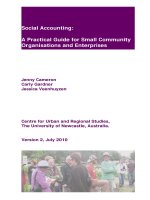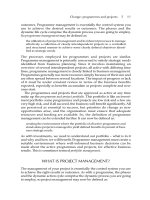THE GROUP SAVINGS RESOURCE BOOK - A practical guide to help groups mobilize and manage their savings ppt
Bạn đang xem bản rút gọn của tài liệu. Xem và tải ngay bản đầy đủ của tài liệu tại đây (161.71 KB, 8 trang )
A practical guide to help groups mobilize and manage
their savings
TT
TT
T
he he
he he
he
gg
gg
g
rr
rr
r
oupoup
oupoup
oup
sasa
sasa
sa
vingsvings
vingsvings
vings
rr
rr
r
esouresour
esouresour
esour
ce bookce book
ce bookce book
ce book
Food and Agriculture Organization of the United Nations
TT
TT
T
he ghe g
he ghe g
he g
rr
rr
r
oupoup
oupoup
oup
sasa
sasa
sa
vingsvings
vingsvings
vings
rr
rr
r
esouresour
esouresour
esour
ce bookce book
ce bookce book
ce book
All rights reserved. Reproduction and dissemination of material in this
information product for educational or other non-commercial purposes are
authorized without any prior written permission from the copyright holders
provided the source is fully acknowledged. Reproduction of material in this
information product for resale or other commercial purposes is prohibited
without written permission of the copyright holders. Applications for such
permission should be addressed to the Chief, Publishing and Multimedia
Service, Information Division, FAO, Viale delle Terme di Caracalla, 00100
Rome, Italy or by e-mail to
© FAO 2002
Text
Ji-Yeune Rim & John Rouse
Illustrations
Rustam Vania
Editing and layout
Jonathan Cook
The designations employed and the presentation of material in this
information product do not imply the expression of any opinion
whatsoever on the part of the Food and Agriculture Organization of
the United Nations concerning the legal status of any country, territory,
city or area or of its authorities, or concerning the delimitation of its
frontiers or boundaries. The word “countries” appearing in the text
refers to countries, territories and areas without distinction. The
designations “developed” and “developing” countries are intended
for statistical convenience and do not necessarily express a judgement
about the stage reached by a particular country or area in the
development process. The opinions expressed in the articles by
contributing authors are not necessarily those of FAO.
CONTENTS
ACKNOWLEDGEMENTS V
FOREWORD VI
INTRODUCTION 1
PART A: SAVING 7
CHAPTER 1: Saving first 8
What is saving? 8
Why people save 8
How people save 9
What about borrowing? 11
How can the poor save more? 12
CHAPTER 2: Getting started 14
Factors enabling or constraining saving 17
Keys to success 22
Tips for group facilitators 26
CHAPTER 3: Saving as a group 29
Rotating Savings and Credit Association (ROSCA) 30
Accumulative Savings and Credit Association (ASCA) 38
Credit Union (Savings and Credit Cooperative) 48
Linking up with banks and other financial institutions 53
iii
PART B: TOOLS 59
CHAPTER 4: Knowing the village 60
Village social map - Who is living where? 61
Wealth ranking - Who is who? 64
Venn diagram - Who is doing what? 66
CHAPTER 5: Money management 70
Household economy map 70
Cash flow tree 72
Seasonal calendar 75
Counting and basic calculations 76
CHAPTER 6: Planning for growth 78
Strengths, weaknesses, opportunities and threats 79
Business plan 81
Participatory monitoring and evaluation 82
REFERENCES 87
iv
ACKNOWLEDGEMENTS
The origins of this book go back to 1991, in our Ghana PPP project,
when we discovered that too much emphasis on credit was
creating dependent groups rather than self-reliant ones. After
several unsuccessful efforts to increase group savings, we found
that socio-cultural factors rather than economic ones appeared
to be the main causes.
Fortunately we met up with Otto Hospes, a socio-economist at
Wageningen University who had done extensive work in this field,
and in 1996, with FAO Partnership Programme funding, we
launched a study to explore the socio-cultural factors influencing
rural saving behaviour in Zambia. This was later expanded, with
generous funding from the Netherlands in 1998 to Tanzania and
Zimbabwe, and served as a major source of information for this
book. Additional valuable insights were collected at an international
workshop on this topic in Wageningen in May 2001.
Creating a simple field manual on resource mobilization for the
poor has involved collaboration with a host of individuals who
deserve much credit.
We therefore wish to thank the members of PPP and other self-
help groups around the world whose struggles to mobilize capital
motivated the idea for this manual.
A special note of gratitude is also owed to Otto Hospes, whose
academic rigour and socio-cultural insights on rural financial
behavior during the research phase were invaluable, to Bernard
Van Heck, Karel Callens, Jennifer Heney and Michael Marx for
their detailed review of and comments on the draft text, to Brian
Branch for his inputs on the credit union section, to Gabrielle
Athmer and Jochem Zoetelief for their field perspectives.
Finally we would like to thank Christine Kahanda of the People’s
Participation Service (PPS) and PPS groups in Zambia. Their
active participation in the field testing of the resource book provided
useful feedback on how to help the poor better mobilize and
manage their own resources to invest in their own future. We
sincerely hope this book will contribute to this end.
v
FOREWORD
In recent years, the potential of microfinance as a tool for poverty
alleviation has been increasingly recognized. Hundreds of millions
of the world’s poorest need access to financial services whether
to access loans or to safely save small amounts of money.
However, mounting evidence from the field has shown that too
much focus on the provision of credit has led to excessive debt
burdens and repressed growth. As a result, many governments,
donors and NGOs are now advocating a more balanced approach
to financing poverty alleviation efforts that places savings and
other financial services in the forefront of credit.
Critics often say that the poor are too poor to save; yet empirical
data contradicts this point-of-view showing that everyone saves,
including the poor. Though not always apparent, the poor save in
many different forms, in kind and in cash, to meet their daily food
consumption, education, and health care needs or to invest in
small businesses. However, the poor frequently have more
difficulties in accumulating capital than the better-off since they
are more vulnerable to risks from bad weather or poor health,
and have limited access to markets and safe saving facilities.
Group saving approaches have had notable successes when they
are responsibly managed, and when the savings are felt as an
asset by their members. Many of these successes have occurred
when women have been significantly involved in their constitution
and management, as has been seen in the case of the Grameen
Bank experience in Bangladesh. By providing a means to safely
pool their savings, these approaches can help the poor and
disadvantaged accumulate productive resources more efficiently.
Group savings also help build solidarity among members and
provide a safety net against exploitative moneylending. Ample
evidence of this exists in the widespread use of informal and formal
group saving approaches around the world: rotating savings and
credit groups, savings clubs, village banks, credit unions, and so
on. The fact that they must be essentially self managed, gives
vi
the opportunity to generate group self-confidence, the first step
towards sustainable poverty elimination.
We hope that this resource book on group savings will prove
useful to those engaged in strengthening the self-help capacities
of the poor, and by doing so, help the poor build a better future for
themselves, their families and their communities.
Maximiliano Cox
Director
FAO Rural Development Division
vii









